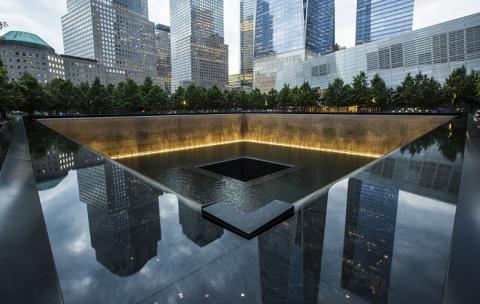Published in the High Desert Advocate in the September 4th, 2020 Edition.

Museum to Reopen to 9/11 Families on September 11, General Public on September 12
The 9/11 Memorial Museum will reopen exclusively for 9/11 family members on the 19th anniversary of 9/11. It will reopen to the public, five days a week, starting on September 12.
All visitors to the 9/11 Memorial & Museum must follow our health and safety guidelines. Masks must be worn on site at all times.
The 9/11 Memorial Museum is making ongoing operational changes in order to provide a safe and healthy environment for all visitors and staff, including:
• Museum capacity will be reduced to 25 percent to allow for proper spacing among visitors
• The Museum’s operating hours have been reduced to allow for deep cleaning
• All tickets must be purchased in advance for timed sessions to allow for proper spacing .
• The Museum will open with a one-way visitor experience with enhanced safety measures throughout
• Certain parts of the Museum will remain closed
The Museum will be open Thursday and Friday from 12 to 7 p.m. and on Saturday through Monday from 10 a.m. to 5 p.m. The Museum will be closed Tuesdays and Wednesdays.
The Memorial’s hours of operation will be adjusted upon Museum reopening to mirror the Museum as much as possible and will remain open 7 days a week, from 12 to 7 p.m. on Thursday and Friday and from 10 a.m. to 5 p.m. on Saturday through Wednesday.
Please check back for ticket sales and more information about the Museum opening.
Learn more about how to get here, accessibility resources, visitor guidelines, and where to visit nearby.
Why did the terrorists attack the World Trade Center and the Pentagon?
The terrorists did not have the capacity to destroy the United States militarily, so they set their sights on symbolic targets instead. The Twin Towers, as the centerpieces of the World Trade Center, symbolized globalization and America’s economic power and prosperity.
The Pentagon, as the headquarters for the U.S. Department of Defense, serves as a symbol of American military power. It is thought that Flight 93 was headed to the Capitol building, the center of American legislative government.
Al-Qaeda hoped that, by attacking these symbols of American power, they would promote widespread fear throughout the country and severely weaken the United States’ standing in the world community, ultimately supporting their political and religious goals in the Middle East and Muslim world.
What countries did the terrorists come from?
Fifteen of the 19 terrorists were from Saudi Arabia. Two were from the United Arab Emirates, one was from Lebanon, and one was from Egypt.
What does Afghanistan have to do with 9/11?
Al-Qaeda was based in Afghanistan. They operated training camps there, and openly lived in the country with the support of the Taliban, an Islamist group that ruled the country.
On September 20, 2001, in a speech to a joint session of Congress, former President George W. Bush asserted: “Any nation that continues to harbor or support terrorism will be regarded by the United States as a hostile regime.” No distinction was made between a harboring state and the terrorists it was harboring. The U.S. government insisted that the Taliban immediately hand over the terrorists and close the training camps or face an attack from the United States. When they refused, “Operation Enduring Freedom” was launched on October 7, 2001, less than a month after the attacks of 9/11.
What is the 9/11 Memorial?
The 9/11 Memorial opened on September 11, 2011, the 10th anniversary of the attacks. It is located on the western side of the former World Trade Center complex where the Twin Towers once stood. The Memorial was designed by two architects, Michael Arad and Peter Walker, whose proposal was selected in a design competition out of 5,201 submissions from 63 countries.
The Memorial Plaza surrounds two enormous reflecting pools set within the footprints of the North and South Towers. This is where the towers used to stand. The pools feature 30-foot waterfalls—the largest man-made waterfalls in North America. The water cascades into reflecting pools, finally disappearing into the center voids. The names of people who were killed in the 9/11 attacks in New York, at the Pentagon, and on Flight 93, as well as in the 1993 bombing at the WTC, are etched in bronze around the edges of the pools.
The plaza is lined with cobblestones and has more than 400 swamp white oak trees, creating a space for reflection separate from the sights and sounds of the surrounding city. The trees were selected from within a 500-mile radius of the WTC site, including nurseries located in New York, Pennsylvania, and near Washington, D.C., to symbolize areas impacted on 9/11.
What is the 9/11 Memorial Museum?
The 9/11 Memorial Museum opened on May 21, 2014. It is located beneath the Memorial Plaza. Visitors enter the Museum through the Pavilion, where two steel “tridents”—remnants of the North Tower’s façade—stand in the building’s Atrium Terrace. The main exhibition space is located seven stories below the 9/11 Memorial at the bedrock foundations of the World Trade Center. The Museum offers displays of artifacts from the WTC and 9/11 attacks, interactive exhibitions, contemplative areas, and programs that convey individual and collective stories relating the experiences of survivors, first responders, area residents, and eyewitnesses. A memorial exhibition honors the individual victims of the attacks.
What was the World Trade Center?
The World Trade Center (WTC) was a 16-acre commercial complex in lower Manhattan that contained seven buildings, a large plaza, and an underground shopping mall that connected six of the buildings. The centerpieces of the complex were the Twin Towers. On September 11, 2001, the entire complex was destroyed in a terrorist attack that has come to be referred to as “9/11.”
What were the Twin Towers?
The Twin Towers were the tallest buildings in New York City. At 110 stories each, 1 WTC (North Tower) and 2 WTC (South Tower) provided nearly 10 million square feet of office space for about 35,000 people and 430 companies. For a brief period upon their completion in 1973, they were the tallest buildings in the world. They attracted roughly 70,000 commuters and tourists daily.
The towers were massive. The North Tower rose 1,368 feet—1,730 feet with a large antenna—and the South Tower stood 1,362 feet high. Views extended 45 miles or more from the top of the towers in every direction—far enough to see all five New York City boroughs, New Jersey, and Connecticut. Each weighed more than 250,000 tons and contained 99 elevators and 21,800 windows. Each floor was an acre in size and there was enough concrete in the towers to build a five-foot-wide sidewalk from New York City to Washington, D.C.
The towers had been the target of an attack before 9/11. On February 26, 1993, terrorists with links to an Islamist extremist group detonated explosives in a van parked underneath the WTC. Six people were killed and thousands were injured.
What happened on 9/11?
“9/11” is shorthand for four coordinated terrorist attacks carried out by al-Qaeda, an Islamist extremist group, that occurred on the morning of September 11, 2001.
Nineteen terrorists from al-Qaeda hijacked four commercial airplanes, deliberately crashing two of the planes into the upper floors of the North and South Towers of the World Trade Center complex and a third plane into the Pentagon in Arlington, Virginia. The Twin Towers ultimately collapsed because of the damage sustained from the impacts and the resulting fires. After learning about the other attacks, passengers on the fourth hijacked plane, Flight 93, fought back, and the plane was crashed into an empty field in western Pennsylvania about 20 minutes by air from Washington, D.C.
The attacks killed 2,977 people from 93 nations: 2,753 people were killed in New York; 184 people were killed at the Pentagon; and 40 people were killed on Flight 93.
What happened at the World Trade Center on 9/11?
The hijacked Flight 11 was crashed into floors 93 to 99 of the North Tower (1 WTC) at 8:46 a.m. The hijacked Flight 175 struck floors 77 to 85 of the South Tower (2 WTC) 17 minutes later at 9:03 a.m. When the towers were struck, between 16,400 and 18,000 people were in the WTC complex. Of those, the vast majority evacuated safely. As they rushed out, first responders rushed in trying to save those still trapped or injured.
The fires from the impacts were intensified by the planes’ burning jet fuel. They weakened the steel support trusses, which attached each of the floors to the buildings’ exterior walls. Along with the initial damage to the buildings’ structural columns, this ultimately caused both towers to collapse. The five other buildings in the WTC complex were also destroyed because of damage sustained when the Twin Towers fell.
The collapse of the buildings left the site devastated. Thousands of volunteers came to Ground Zero to help with the rescue, recovery, and clean-up efforts, and on May 30, 2002, the last piece of WTC steel was ceremonially removed.
What is Islam?
Islam is the world’s second-largest religion. An adherent of Islam is a Muslim. Islam’s beliefs and practices center around two key sources: the Qur’an and the Hadith. The Qur’an contains what Muslims believe is God’s final revelation, made to the Prophet Muhammad, Islam’s founder, more than 1,400 years ago. The Hadith is a collection of Muhammad’s sayings and deeds during his life.
What is an Islamist extremist?
“Islamists” see Islam as a guiding ideology for politics and the organization of society. That is, they believe that strict adherence to religious law should be the sole basis for a country’s law, as well as its cultural and social life. While some Muslims believe this, many do not. Islamist extremists believe violence is acceptable to achieve these ends. Al-Qaeda is one of many Islamist extremist groups.
What is al-Qaeda?
Al-Qaeda is an international Islamist extremist terrorist network founded in the late 1980s by Osama bin Laden, who was killed in a U.S. military operation on May 1, 2011, and others who were involved in the war against the Soviet Union in Afghanistan. Their aim has been to overthrow governments in the Middle East, and elsewhere in the Muslim world, which do not strictly enforce a religiously sanctioned political and social order. Attacks against the United States were intended to reduce American support for many of these governments; U.S. support was viewed by al-Qaeda as a major obstacle to creating a global order under Islamic authority.
They have claimed responsibility for numerous terrorist attacks since the early 1990s, including the 1998 U.S. Embassy bombings in Kenya and Tanzania, the 2000 attack on the USS Cole, and the 9/11 attacks. They have also aligned themselves with and inspired other terrorist groups who have carried out attacks, including the 2002 Bali bombing, the 2004 Madrid train bombing, the 2005 London bombings, and the 2008 Mumbai terrorist attacks, among many others.

